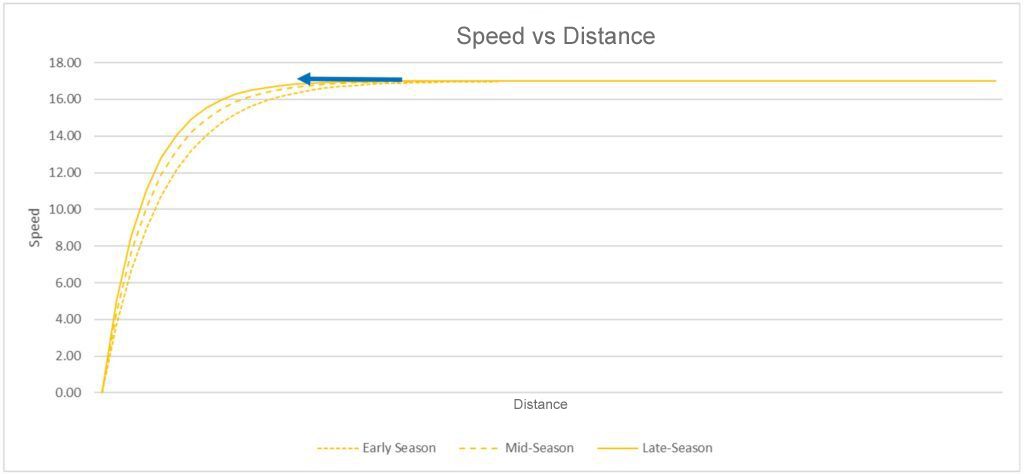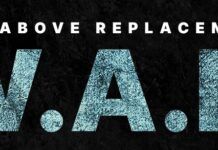This post is going to discuss what a good race start looks like and why. It will also show you some different race starts.
The Physics of a Race Start
A dragon boat race start is a classic example of fluid dynamics. Here we are, trying to accelerate a solid object (boat) from standstill in a fluid (water). This fluid produces drag on the boat, trying to slow it down.
The faster the boat goes, the more drag the fluid exerts. This battle continues until the force produced by the paddlers equals the drag force produced by the water. At this point, the boat’s speed remains constant. This is your race pace.

The Classic Dragon Boat race start sequence looks like Figure 2 when you graph speed against distance. So why does the race start graph look like this?

The reason why the graph looks like this and not, say, a straight line, is because of the relationship between the speed of the boat in one direction and drag from the water in the opposite direction.
One would guess that if you doubled the speed then you would double the drag but this is not so. A closer look at the drag formula will show you that the drag goes up as the square of the speed (velocity).
DRAG FORMULA
Drag = ½ x C x p x A x v2
p = fluid density (salt water, fresh water, hot water, cold water, air, oil, etc.)
C = drag coefficient (how streamlined the boat hull)
A = cross sectional area (the area of boat hull pushing through the water)
v = relative velocity (difference between the speed of the boat and the water)
That’s means if you double the speed (2 x) of the boat you will quadruple the drag (4 x). So as the speed increases, the drag increases even quicker. This is what leads to the graph shape above.
Different Race Starts
Different crews have different start sequences. The coach will select one of the following and maybe tweak it a little to suit their crew. Here are three different race start strategies that you may see.
Gear Changes
One type of race start sequence involves breaking the start up into separate phases.
One example could be: 6 big powerful strokes, 10 high rate strokes, 3 transition strokes into 20 long and strong strokes.
As you can see there are distinctive “gear changes” during this race start sequence and these can be reflected in a race sequence graph like Figure 3.

Why would a coach have a sequence such as this? One reason could be that for an inexperienced crew trying to “feel” their way through a start sequence may result in the rate going up too fast (spinning their wheels) or too slow (taking too long to get to race pace).
Remember, on race days the water conditions are different, the boat may not be your club’s, there may be slight changes in crew and therefore power, and then there are the weather conditions. All of these variables have an effect on the race start.
Is this a bad race sequence? Not necessarily. But it does need tweaking to approach the ideal shape (Figure 2).
There are two things that can be done to fix the shape of Figure 3:
- Change “gears” earlier – before the curve starts flattening out. For example 4-8-3-20 will produce a better shaped start graph.
- Get more power out of the crew (at all stroke rates). That way the drag forces do not start to win during each gear.
The graphs below is the same crew mid-season and then later in the season still doing the 6-10-3-20 race start. Notice how the shape of the graphs in Figures 4 and 5 are getting a lot closer to the classic start sequence shape (Figure 2)


The gear change race starts can be a good option for inexperienced teams as it breaks the start sequence into distinct chunks that do not rely on the crew “feeling” what the stroke rate should be. The disadvantage is that any “gear change” curve flattening needs to be ironed out.
Constant Stroke Rate
Another race start sequence that I have trialed is based on the stroke rate at which the crew produces maximum power. Some crews produce maximum power at low stroke rates, others at high.
The theory is, if a crew produces their maximum power at a particular stroke rate maybe that is the best way to start a race.
For this to work, the crew may have to shorten their stroke length (a lot) at the beginning of the race sequence, gradually lengthening it as the boat accelerates.

As you can see, the shape of the graph in Figure 6 is very close to the ideal race start sequence shape in Figure 2.
I have tried this with various crews and it has shown some promise. I have not heard many other coaches trying it though. The underlying theory is to keep the stroke rate constant (in the crew’s power band) and vary the stroke length as the boat speed increases. This works well for inexperienced and experienced crews alike.
Constant Stroke Length
This race start sequence is very popular. In this one, apart from maybe the first stroke or so, the stroke length stays approximately the same but the rate increases.
As you may have seen from past posts (Laying it All on the Table), there is a solid link between stroke length and stroke rate. Therefore, the shape of the race start sequence for this method is similar to the one in Figure 6 and therefore Figure 2.
Where this start sequence can fall down is when the crew lifts the rate before the boat speed is adequate (spinning the wheels) or lifts the rate too slowly (too long to top speed). The analogy is like not changing gears in your car at the correct speed.
The Shape is Good. What Now?
Once the crew can consistently produce the classic race start shape graph (Figure 2), all that is left to do is “lift it up and forward”. That is hit a higher top speed, and earlier.
This achieved through strength training, technique training and better timing. For example, in the graph below the average speed in Figure 7 has increased from 12kph to 15.7kph by “lifting the graph up”.

As you can see the shape of the race start stays the same. With better strength, technique and timing, we can get to a higher top speed before increased drag will match our efforts.
The next stage is to get to that top speed quicker. The faster you get to your top speed (i.e. in the least distance) the better your average speed will be.
This is done through more training, but also tweaks such as lightening the load (no water in the boat, including bottles), experienced sweeps, laser focus on the first three or four strokes, the power to weight ratio of the crew.
For example by hitting top speed earlier, the average speed in Figure 8 has now increased from 15.7kph to 16.1kph even though the top speed is the same.

Putting the whole plan together shows the race start improvement from early season to late season. This crew’s average speed in Figure 9 has increased over the season from 12.0kph to 16.1kph.
How does that show in race day results? This crew’s 200 metre time has improved from 59.8 seconds to 44.8 seconds.

Conclusion
The race start sequence is a critical part of every race. The one that is best for your crew is determined by your coach. You will recognise that is one of the three described above or maybe a slight variation of one of them.
The aim of a good race start sequence is to get to maximum race speed as quickly as you can.
Getting your race start sequence right will go a long way towards success.














Thanks. Lots of valuable information for a new coach.
Thanks Julie,
I am glad this helps. If you need anything else covered, send me a message.
Cheers
Mark